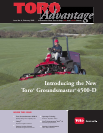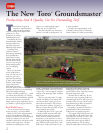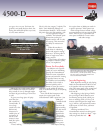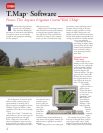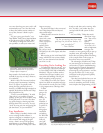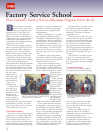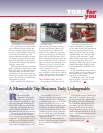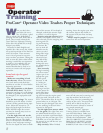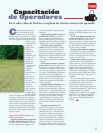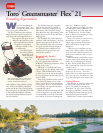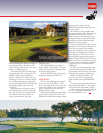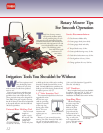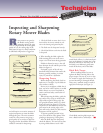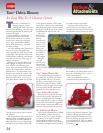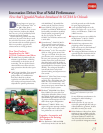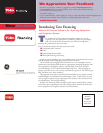
R
otary mowers cut grass by
the blade’s cutting surface
impacting against the grass
stems at a high velocity. To ensure good
quality of cut, the cutting edge of the
blade must be kept in a sharp condition.
A dull blade will produce a ragged cut
and will require an excessive amount of
engine horsepower to rotate the blade
through the grass. The most common
causes for rotary mowers not giving a
good quality of cut are due to dull cut-
ting edges and/or bent blades. Whenever
a blade is removed for sharpening:
1. Check the blades to ensure that it is not
bent and has the correct attitude in rela-
tion to the housing and ground surface.
2. The blade must be sharpened correctly.
3. Check blade balance each time the blade
is sharpened.
4. When installing the blade, tighten the
blade retaining bolt or nut to the correct
torque so it will not loosen during operation.
If blade is allowed to wear, a slot will
form between the sail and flat part of the
blade (see figure 1).
Eventually a piece of the sail may
break off and be thrown from under the
housing, possibly resulting in serious
injury to yourself or a bystander.
Sharpening Process
Before sharpening the blade, check to
make sure it is straight. Lay the blade on
a flat surface to check.
Do not try to straighten a blade that is
bent, and never weld a broken or cracked
blade. Always use a new Toro blade to
ensure continued safety certification of
the product.
When sharpening the blade, grind the
top surface only, trying to maintain the
angle of the original cutting edge. Do
not grind the bottom surface or a chisel
shape will result (see figure 2). The low-
est portion on the blade that contacts the
grass must be the cutting edge or the
grass will not be cleanly cut and excessive
horsepower will be required.
To prevent possible personal injury,
wear a face shield or safety glasses when
grinding or sharpening is being done.
After the blade has been sharpened,
check the balance. This can best be done
by using a blade balancer tool. A bal-
anced blade will stay in a horizontal posi-
tion on the balancer. A blade that is not
balanced will settle to the heavy side. If
the blade is not balanced, grind some
metal off the heavy end of the blade.
Blade Bolt Torque
When installing blades, be sure to
tighten the blade retaining bolt to the
proper torque. Do not use an air or elec-
tric wrench to apply the final torque. To
prevent loosening or damaged threads,
always use a standard torque wrench to
apply the final torque (see figure 3).
Check blade retaining bolt torque any
time a blade has hit a solid object.
13
Technician
tips
Inspecting and Sharpening
Rotary Mower Blades
Customer Care Available at www.toro.com/golf
DO NOT grind bottom of cutting edge.
This will cause poor quality of cut and
demand higher horsepower.
Grind top side of cutting edge only.
Ideal angle for cutting edge is 30º.
INCORRECT This will cause poor quality
of cut and high horsepower requirement.
CORRECT
CORRECT
FLAT PART
OF BLADE
SAIL
SLOT
FORMED
SAIL
WEAR
SAIL
INCORRECT Bent lades will cause poor quality
of cut and demand higher horsepower.
Figure 1
Figure 2
Figure 3



